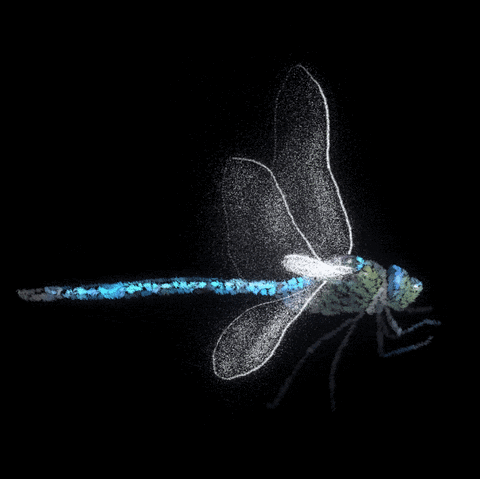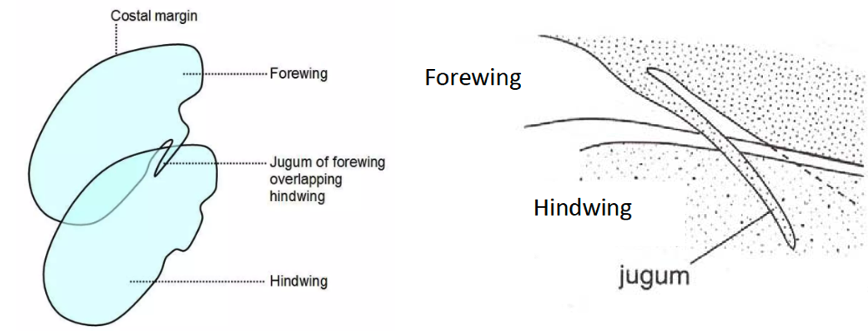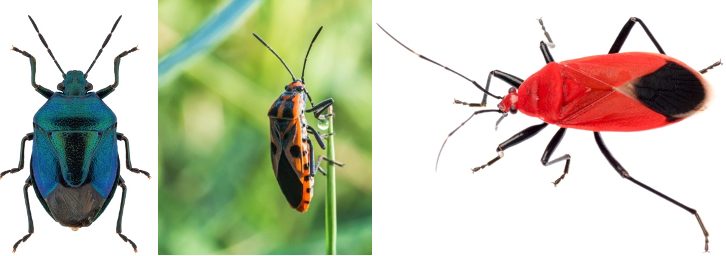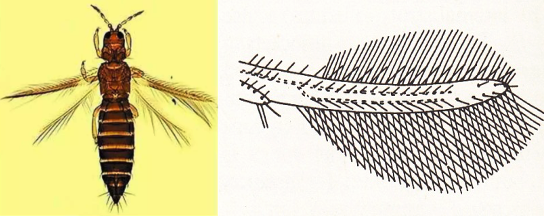🪽 Wing Modifications
Types of Wing Couplings, Insect Wing Modifications with examples
Which of the following statment is correct?
Wing Coupling
- Among the insects with two pairs of wings, the wings may work separately as in the dragonflies and damselflies.

- But in higher pterygote insects, fore and hind wings are coupled together as a unit, so that both pairs move synchronously. By coupling the wings the insects become functionally two winged. The forewing and hindwing are coupled together, which improves the aerodynamic efficiency of flight.
- For taking flight, insect need to keep both the fore and hindwings together as a
single unit. The structures in the form of lobes, bristles, hairs or spines that help the wings to be together are known as wing coupling organs.
Types of Wing Coupling
1. Hamulate

- A row of small, curved hook like structures present on the costal margin of the hind wing known as Hamuli that fit into the upward fold of the anal margin of the forewing which lock onto the forewing, keeping them held together (hamulate coupling).
- The most common coupling mechanism.
- E.g.: Hymenopterans (wasps and bees).
2. Jugate Type or Jugum Type

- The anal margin (jugal region) of the fore wing possesses a small lobe at its base called fibula, which rest on the surface of the hind wing or sometimes engages with spines present on the upper surface of hind wings.
- E.g.: Primitive lepidopterans of the family Hepialidae.
3. Amplexiform Type

- It is the simplest form of wing coupling.
- A linking structure is absent.
- Coupling is achieved by broad overlapping of adjacent margins. Costal margin of hind wing and anal margin of forewing overlap one above the other.
- E.g.
Butterflies.
4. Frenate or Retinaculum Type
- The hind wings possess bristle or spine like structure or group of hairs known as frenulum.
- The forewings possess hook like retinaculum on anal side.
- During flight the frenulum passes beneath the retinaculum and thus the both the wings are kept together.
- E.g., Fruit sucking moths and hawk moths, there are two sub types.


i. Male frenate
- Hindwing bears near the base of the coastal margin a stout bristle called frenulum which is normally held by a curved process, retinaculum arising from the subcostal vein found on the surface of the forewing.
ii. Female frenate
- Hindwing bears near the base of the costal margin a group of stout bristle (frenulum) which lies beneath extended forewing and engages there in a retinaculum formed by a patch of hairs near cubitus.
Wing Types
- Each order and insect family has distinctive wing shapes and features.
1. Tegmina

- Forewings are leathery parchment like and tough.
- They protect the membranous hindwings.
- They are not used for flight.
- E.g.: forewings wings of cockroach, grasshopper.
2. Elytra

- The wing is heavily sclerotised, hard, shell like without clear venation.
- They form horny sheet and protect the membranous hind wings and abdomen.
- Wing venation is lost.
- It is not used during flight. The elytra must be raised in order to move the hind flight wings.
- E.g., fore wings of beetles and weevils.
3. Hemelytra

- The basal half of the wing is thick (like elytra) and leathery and distal half is membranous.
- They are not involved in flight and are protective in function.
- E.g. fore wing of bugs.
4. Scaly wings

- Wings of butterfly and moths are covered with small, coloured scales.
- Scales are unicellular flattened outgrowth of body wall.
- Scales are inclined to the wing surface and overlap each other to form a complete covering. Scales are responsible for colour.
- They are useful for flight.
- E.g.: Both the wings of moths and butterflies.
5. Membranous wings

- They are thin, transparent wings (clear venation) and supported by a system of tubular veins.
- In many insects either forewings (true flies) or hind wings (grasshopper, cockroach, beetles and bugs) or both fore wings and hind wings (wasp, bees, dragonfly and damselfly) are membranous.
- Always useful of flight.
6. Halteres

- In true flies the hind wings are modified into small knobbed vibrating organs called haltere.
- They act as balancing organs and provide the needed stability during flight by acting similar to gyroscopes.
- E.g. true flies, mosquito, male scale insect and front wings of male stylopids.
7. Pseudohalteres

- When forewings are modified into halters, they are known as pseudo-halteres.
- They are short and dumbbell shaped.
- E.g.: Front wings of Strepsiptera.
8. Fringed wings

- The wings are fringed with long marginal hairs giving a feather like appearance.
- These insects literally swim through the air.
- E.g.: Both the wings of thrips.
9. Fissured wings

- Forewings are longitudinally divided twice forming a fork like structure whereas hindwings are divided twice into three arms.
- All the forks possess small marginal hairs.
- They are useful for flight.
- E.g.: Both the wings of plume moth.
References
- Insecta - Introduction: K.N. Ragumoorithi, V. Balasurbramani & N. Natarajan
- A General Textbook of Entomology (9th edition, 1960) – A.D. Imms (Revised by Professor O.W. Richards and R.G. Davies). Butler & Tanner Ltd., Frome and London.
- The Insects- Structure and Function (4th Edition, 1998) – R.F. Chapman. Cambridge University Press
- Wikipedia
Which of the following statment is correct?
Wing Coupling
- Among the insects with two pairs of wings, the wings may work separately as in the dragonflies and damselflies.

- But in higher pterygote insects, fore and hind wings are coupled together as a unit, so that both pairs move synchronously. By coupling the wings the insects become functionally two winged. The forewing and hindwing are coupled together, which improves the aerodynamic efficiency of flight.
- For taking flight, insect need to keep both the fore and hindwings together as a
single unit. The structures in the form of lobes, bristles, hairs or spines that help the wings to be together are known as wing coupling organs.
Types of Wing Coupling
1. Hamulate

- A row of small, curved hook like structures present on the …
Become Successful With AgriDots
Learn the essential skills for getting a seat in the Exam with
🦄 You are a pro member!
Only use this page if purchasing a gift or enterprise account
Plan
Rs
- Unlimited access to PRO courses
- Quizzes with hand-picked meme prizes
- Invite to private Discord chat
- Free Sticker emailed
Lifetime
Rs
1,499
once
- All PRO-tier benefits
- Single payment, lifetime access
- 4,200 bonus xp points
- Next Level
T-shirt shipped worldwide

Yo! You just found a 20% discount using 👉 EASTEREGG

High-quality fitted cotton shirt produced by Next Level Apparel